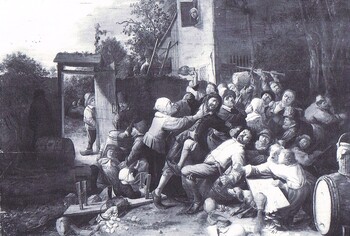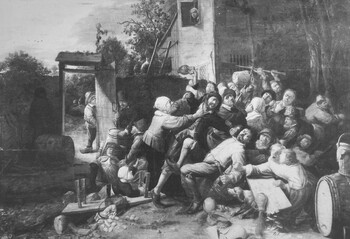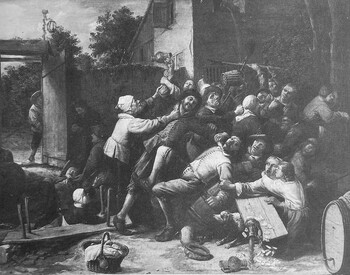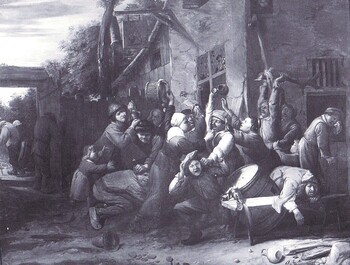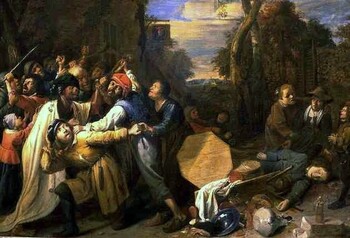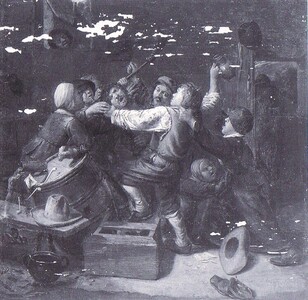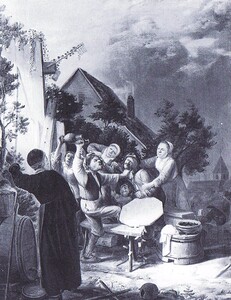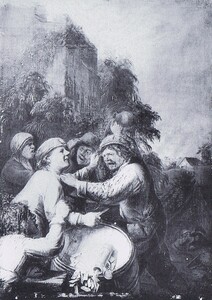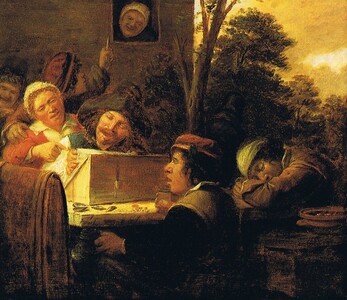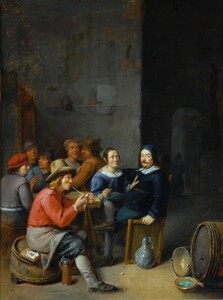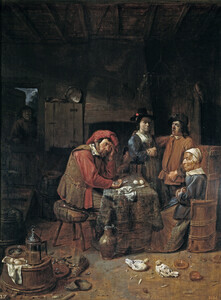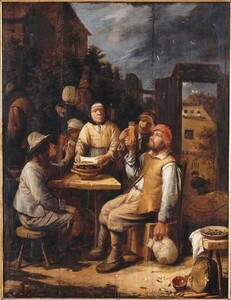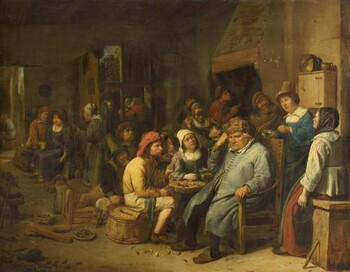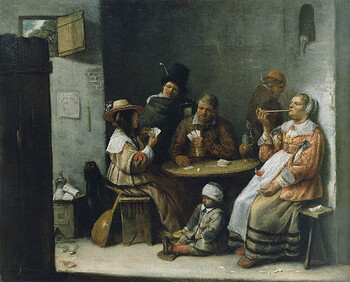8.100 €
A fight outside a tavern over a card game
Oil on canvas : 76,2 X 106,6 cm
Unsigned, middle 17th century
Frame : 93,4 X 124,0 cm
Provenance : Galleria Caretto Turin during the early 1990
Published : by Karolien De Clippel in « Joos van Craesbeeck », 2006, under Cat. Nr. A96, P. 236/237
(with slightly different dimensions)
In short
Joos van Craesbeeck was strongly influenced by his Master, Adriaen Brouwer. Both painted sharply observed low life scenes.
Van Craesbeeck was a skilled farce painter: he introduced himself regularly as one of the sinful fighting, drinking, grimacing characters in his own tavern and brothel scenes. In this very composition he had a brilliant idea: the painter stood model for both main fighters at the very centre of the painting.
Of our virtuoso composition exist four versions: three are monogrammed “CB”, ours is not. Consequently the author of the monograph on van Craesbeeck, Karolien De Clippel, considered in 2006 our painting to be a workshop replica.
About Joos van Craesbeeck
Flemish painter
Neerlinter circa 1608 – before 1662 Brussels
Painter of genre scenes.
Van Craesbeeck was the son of a baker, he initially also trained as a baker. Following his marriage with the daughter of the baker of the citadel of Antwerp in 1631, our future painter worked with his brother-in-law: he delivered bread to the citadel where in 1633 the famous genre and landscape painter Adriaen Brouwer (1605/06 – 1638) was imprisoned, because of tax debts. The two men must already have been close friends before. Van Craesbeeck studied painting under Brouwer and became himself a painter.
Brouwer can be considered the inventor of low-life genre scenes, which could be rather crude and sordid. Although his paintings were very sought after and his prices were very high he seems during his short life to have had debts very regularly. He influenced strongly the Flemish painters Joos van Craesbeeck, David Teniers II (1610 – 1690), David Ryckaert III (1612 – 1661) and Gillis II van Tilborgh (1615 – 1675), as well as many Dutch painters, for he had also been active in Amsterdam and Haarlem.
Van Craesbeeck’s wife family counted several artists: the landscape painter Jan Tielens and the sculptors Melchior and Caspar Grison were her uncles.
In the year 1633/34 van Craesbeeck joined the Painter’s Guild of Saint Luke in Antwerp. At the start of his career he remained also active as a baker. In two years time, 1637/1638, he lost both his wife (the couple had no children) and his master-friend Brouwer.
Van Craesbeeck lived as a painter in Antwerp until 1650/51, when he moved to Brussels, probably for financial reasons: with the Peace Treaty of Westphalia in 1648 the river Scheldt, the entrance gate to the harbour of Antwerp, was blocked by the Dutch Republic, so that the economic activity in Antwerp got more and more reduced. Several painters, among them David Teniers II and van Craesbeeck left Antwerp for Brussels.
Like Brouwer van Craesbeeck favoured painting peasants in or outside taverns or brothels drinking, carousing, playing cards, smoking, quarrelling and falling in love. Through depictions of what goes wrong and the implications of their behaviour on their tempestuous lives he and his colleague genre painters gave a moral message to their, by Humanism inspired, clients.
The early works of van Craesbeeck clearly show the influence of Brouwer in subject-matter, figure-types, expressive emotions and in style, favouring brownish tonalities.
Following Brouwer’s death in 1638 he got more and more influenced by David Teniers II and he turned also to depictions of the middle-class world in more subtle harmonizing toning.
Finally in his Brussels years he started using vivid colours. The genre scene painter Adriaen Rombouts was his best-known pupil here.
About our painting
Karolien De Clippel published in 2006 in her study of the paintings of Joos van Craesbeeck four versions of the same composition of this Fight outside a tavern. Three are monogrammed, ours in not. Therefore De Clippel has not attributed it to van Craesbeeck. The author dates the composition to the second half of the 1650s.
- Catalogue number 96 is painted on panel and sits in the Musée des Beaux-Arts in Dijon. It is slightly smaller than our painting.
- Number 96A is a monogrammed, but much larger replica, after this composition.
- Our painting also copies the Dijon painting.
- Number A97 is a smaller variation on panel, with some minor differences, of the Dijon painting.
Our composition of a fight between drunken bumpkins at a card game makes a particularly convincing, realistic impression. Van Craesbeeck painted various “tronies”, psychological self-studies depicting himself lightly with a violent grimace. But he went even a step further, representing himself regularly in tavern or brothel scenes as one of the sinful, drunken, fighting peasants, thus guaranteeing the lifelikeness of the scene. Jacob Jordaens in Antwerp and Jan Steen in Holland introduced themselves also regularly in their genre scenes.
But then what to think of this brilliant discovery? At the centre of our composition van Craesbeeck stood model for both protagonists, for the two main fighters: the figure with the blue beret, a typical hat for a painter, who wants to hit with a jug a falling man, who is holding a knife. What an ingenious tric: he stood twice model for a figure.
Why should you buy this painting?
Because it is an icon of Flemish genre scene painting.
Comparative paintings
Click photos for more details

